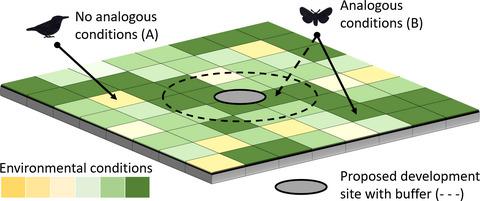当前位置:
X-MOL 学术
›
J. Appl. Ecol.
›
论文详情
Our official English website, www.x-mol.net, welcomes your feedback! (Note: you will need to create a separate account there.)
Species distribution modelling is needed to support ecological impact assessments
Journal of Applied Ecology ( IF 5.7 ) Pub Date : 2020-10-26 , DOI: 10.1111/1365-2664.13782 David J. Baker 1 , Ilya M. D. Maclean 1 , Martin Goodall 2 , Kevin J. Gaston 1
中文翻译:

需要建立物种分布模型来支持生态影响评估
更新日期:2020-10-26
Journal of Applied Ecology ( IF 5.7 ) Pub Date : 2020-10-26 , DOI: 10.1111/1365-2664.13782 David J. Baker 1 , Ilya M. D. Maclean 1 , Martin Goodall 2 , Kevin J. Gaston 1
Affiliation

|
- Legislation commonly mandates the mitigation of impacts to biodiversity in planning and development processes, with potential impacts identified through some form of ecological impact assessment. Yet, protections for biodiversity are frequently undermined because the distributions of priority species are poorly known in most locations at the spatial scales required to inform planning decisions (i.e. c. 1–100 ha).
- Planning applications are often screened against opportunistic records to determine potential impacts to priority species. However, raw occurrence records provide information only on where a species has been detected and cannot be used to indicate if a species is likely to be absent from a site.
- Inferences drawn from these data on the likelihood of a species being present at a site can only be correctly interpreted through an appropriate species distribution modelling (SDM) framework that ensures assumptions about the data and models are formalised and documented. We argue that SDM frameworks must be integrated into ecological impact assessments to improve support for biodiversity protections within planning and development processes.
- Biases and uncertainties in opportunistic data create modelling challenges, but recent methodological advances can minimise their impacts on predictions. We advocate co‐production with practitioners of SDM tools, mapping products and best‐practice guidelines specific to planning processes.
- Policy implications. The integration of species distribution modelling frameworks into ecological impact assessments will strengthen biodiversity protections in planning and development processes by ensuring methodological transparency and rigour in the interpretation of species occurrence data.
中文翻译:

需要建立物种分布模型来支持生态影响评估
- 立法通常要求在规划和发展过程中减轻对生物多样性的影响,并通过某种形式的生态影响评估来确定潜在影响。然而,对于生物多样性的保护,经常受到损害,因为优先物种的分布在告知规划决策所需要的空间尺度(即大部分位置是知之甚少Ç。1-100公顷)。
- 通常会根据机会记录来筛选计划应用程序,以确定对优先物种的潜在影响。但是,原始发生记录仅提供有关在何处检测到某种物种的信息,不能用于指示某个地点是否可能存在某种物种。
- 从这些数据中得出的关于某个物种存在某个地点的可能性的推论只能通过适当的物种分布模型(SDM)框架来正确解释,该框架可确保对数据和模型的假设进行形式化和记录。我们认为,必须将SDM框架整合到生态影响评估中,以在规划和开发过程中改善对生物多样性保护的支持。
- 机会数据的偏差和不确定性给建模带来了挑战,但是最近的方法学进步可以将其对预测的影响降到最低。我们提倡与SDM工具,映射产品和计划过程特定的最佳实践指南的从业者共同制作。
- 政策含义。将物种分布建模框架纳入生态影响评估,将通过确保方法的透明性和对物种发生数据的解释的严格性,在规划和发展过程中加强对生物多样性的保护。


























 京公网安备 11010802027423号
京公网安备 11010802027423号